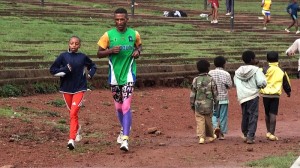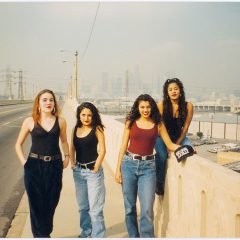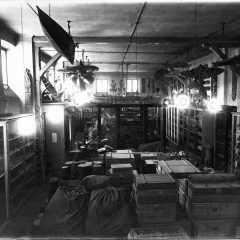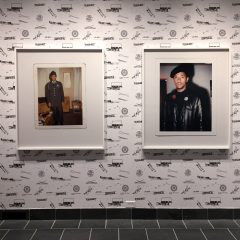Possible Cities; Africa in Photography and Video at Haverford College’s Cantor Fitzgerald Gallery through April 29, 2011 was organized by Ruti Talmor, Mellon Postdoctoral fellow, around two considerations: that contemporary Africa is largely urban, and that the work should counter the fact that most images that circulate internationally represent the continent either as a vast nature preserve or as overwhelmed with poverty, health crises and political and social conflicts. No one who has seen international exhibitions during the past decade is likely to have such a narrow view (nor would viewers of The Global Africa Project, currently at the Museum of Arts and Design, New York, which I wrote about on March 20), but that doesn’t diminish the interest of work on view by four photographers: Sammy Baloji (D R Congo), Pieter Hugo (South Africa), Sabelo Mlangeni (South Africa), Guy Tillim (South Africa), and three video artists, two of whom work as a pair: Salem Mekuria (Ethopia) and IngridMwangiRobertHutter (Kenya, Germany).

The photography shares the large size and technical refinement of international norms. Many of the themes have international currency as well: uncovering political and social exploitation of the past, peeling off the façade of media stereotypes (established by Nigeria’s Nollywood rather than California’s Hollywood), investigating the construction of memory and of national histories, observing the remains of failed utopian aspiration, and exposing the hidden lives of society’s poorest and most marginalized members.
Despite the familiarity of the works’ format, much of the content requires a certain amount of back story to appreciate its meaning; some, but not all, of this is provided by the exhibition labels and the attractive catalog which is available (free) at the gallery. But much of the subtlety certainly depends upon a detailed knowledge of the history and present circumstance of places likely to be unfamiliar to most visitors. Pieter Hugo’s striking portraits of oddly-costumed figures in unexplained settings resemble a style of fashion photography popularized by Irving Penn and others; but it turns out the characters are ordinary people, made up and attired by film technicians to conform to popular, Nollywood types and photographed in non-filmic settings (Nollywood refers to the popular film industry of Nigeria, the world’s second largest after India; its films are distributed throughout Africa and the African diaspora). The man, attired in a dark suit and tie, with one foot resting upon a slaughtered bull as he holds its heart aloft, turns out to refer to working-class suspicions that great wealth is associated with occult practices. The curator suggests that to the uninformed Western viewer…, the man standing over a bull with his [sic] heart in his hand might represent all that “Africa” as sign stands for in the Western imagination; this strikes me as both facile and unlikely. The image is simply too odd to conform to anyone’s pre-conceptions. My first response was bewilderment; what is going on here? The image of three girls playing at being a heavily-armed gang is rather more straightforward.

The pensive, three-channel video installation, Square Stories, by Salem Mekuria, is an exploration of the varying political and social history of a central space in Addis Ababa. Young people today, training for sports events in a thoroughly global environment of automobiles and Coca-Cola signs, bear obvious comparison to soldiers under Mengistu’s rule who would have had similar physical training, and who were responsible for dreadful civilian slaughter. The record of that violence is the subject of a museum built on the square; its images of the executions and the extent of the killing are recorded on cell-phones, by visitors too young to remember the events. The elderly woman being guided through her family home, which has been converted to another national museum, is again a meditation on changing times. But subtler connections with the events of Ethiopia’s recent past are likely to be lost in translation.

Guy Tillim‘s arresting and beautiful photographs from the series Avenue Patrice Lumumba record a number of late-colonial buildings that Tillim had visited across West Africa during the violent period of Lumumba’s post-colonial rule in the Congo. Each of the four on view portrays a very different picture, and while according to the catalog, Tillim has said that the photographs are not histories of collapsed post-colonial African States, it is hard to see anything else in his image of the laundry of the poor, who have taken residence in the abandoned, modernist grandeur of the Grand Hotel, Beira, Mozambique. Tillim’s image of Athenee Royal High School, Lubumbashi, DR Congo, however, portrays a group of high school students going about their day with a calm ordinariness that students at West Philadelphia High School can only imagine; the boarded up windows behind them are clearly not the dominant influence in their surroundings.
Symposium: Imaging Africa
On Saturday, March 19, Talmor also organized the symposium, Imaging Africa, which brought together an extraordinarily international group of scholars, curators and filmmakers – an amazing achievement for a small, liberal arts college. They addressed a broad range of questions about photography, film and video by Africans and members of the African diaspora: its place within global discussions of post-modern art, its interaction with Northern photography, its circulation and control of its production, and its role in explorations of evolving identities.
The symposium opened with Renee Mussai, curator at Autograph, London, an organization devoted to photography that addresses issues of identity and social justice. She began, as did most speakers, by emphasizing that Africa is not a single entity, despite our tendency to treat it so, and raised a subject that was central to the entire day’s discussion: that of modernity. The concept, which grew out of a particular, European history of the transition to industrialization and an artistic turn away from academic and traditional forms to artistic self-exploration, sits uneasily in post-colonial states without a parallel historic sequence; India certainly faces the same question. What is African modernity ? Musai dated the change of photography’s position and the concern for modernity in Africa with Malik Sidibe’s winning the Golden Lion award at the 2008 Venice Biennale.
The award-winning British filmmaker, John Akomfrah spoke of a problem that arose in his, so far, unsuccessful attempt to make a film about Fela Kuti, the Nigerian musician, political activist and self-proclaimed Black President. Kuti lived in a commune, Kalakuta, which appointed one of its members, Femi Osula, to take photographic records of commune activities. The photos were occasionally used by members to portray Kalakuta’s activities to the outside world, more or less as political propaganda. When Akomfrah found the photographs he considered them an archive; but who owns them? Femi Osula? The commune? The situation was too uncertain for Akomfrah’s possible backers, so the film exists only in the form of the tantalizing trailer made to attract funding.
Jennifer Bajorek, lecturer at Goldsmith’s College, London, described the complexity of African photography whose status and economic rewards have often been determined by Northerners. Exhibitors at the Bamako Biennial of African Photography are controlled by its French sponsors whose decisions, Bajorek found, seemed largely based upon competition with German sponsors. In Zimbabwe, all news photography was taken by licensed members of either BBC or CNN news staff until both agencies were barred from the country. At that point the only source of photographs were the African photo-journalists whose work had previously been excluded from international view.
Awam Amkpa, professor of drama at NYU, suggested that Africa should be thought of in terms of overlapping modernisms which create an oppositional stance toward European modernism. He emphasized the fact that, as diverse as Africans are, many now identify beyond tribal or national divisions, and he spoke of an aesthetic of displacement and fragmentation, with some movement towards a creolization of conventions. Where, he asked, would such creolized works be legible? How would we read them?








